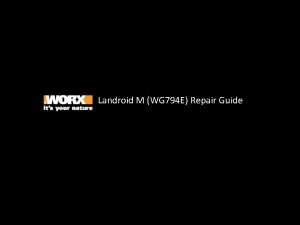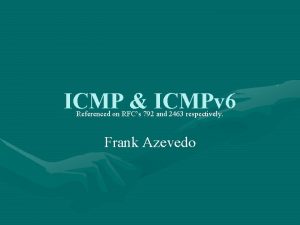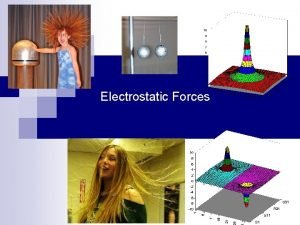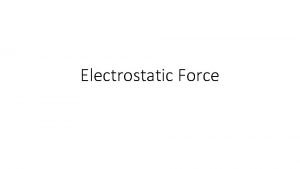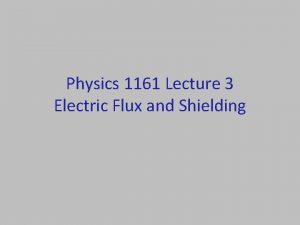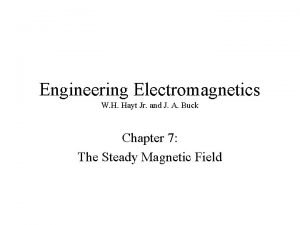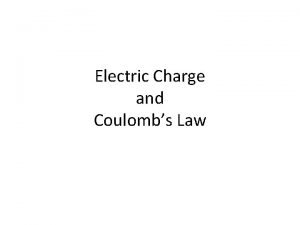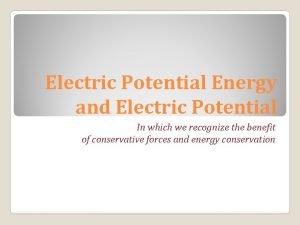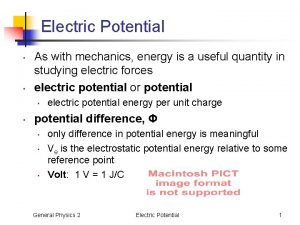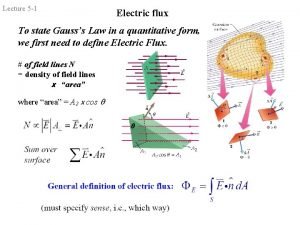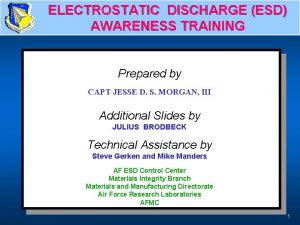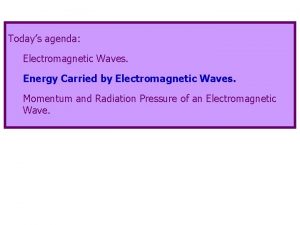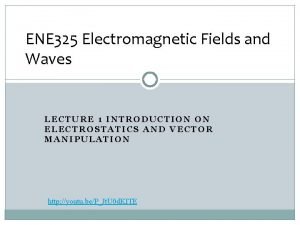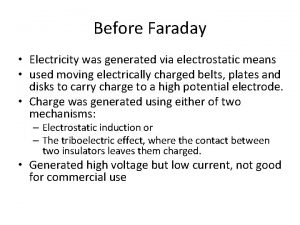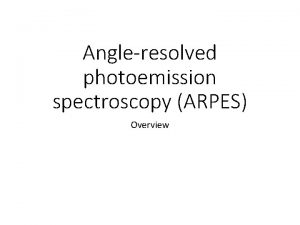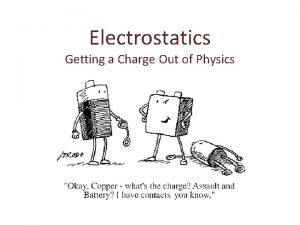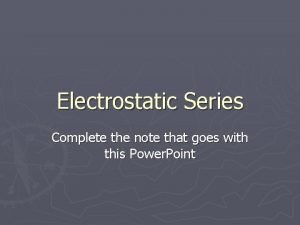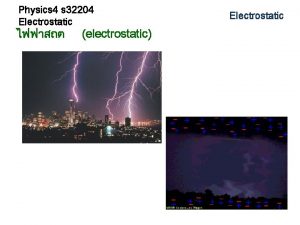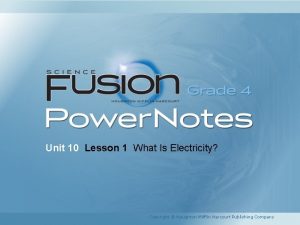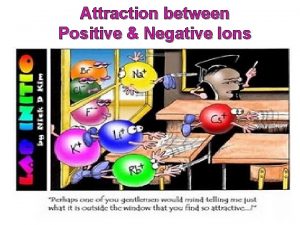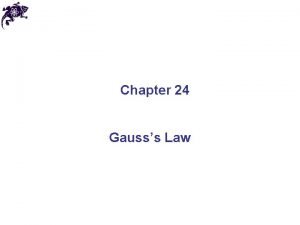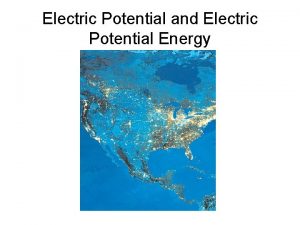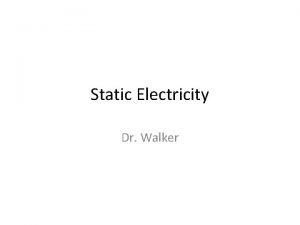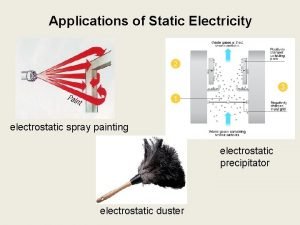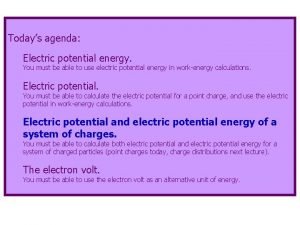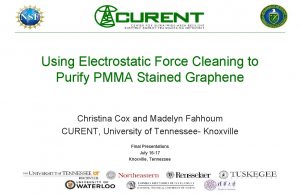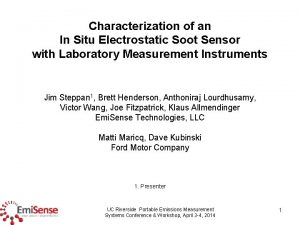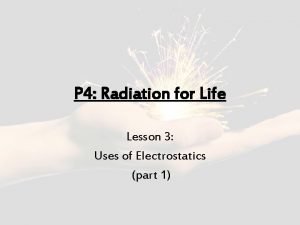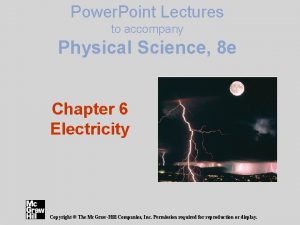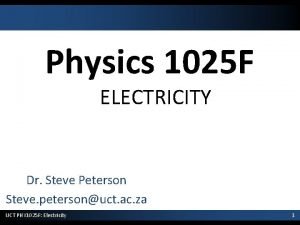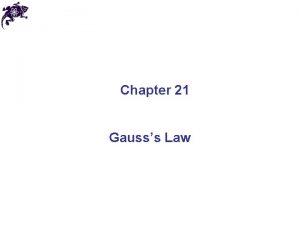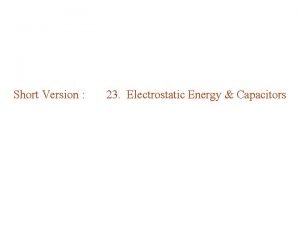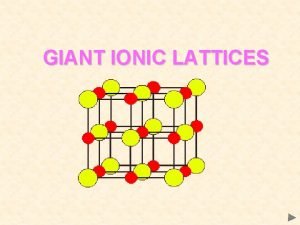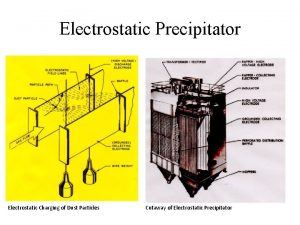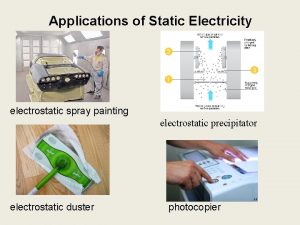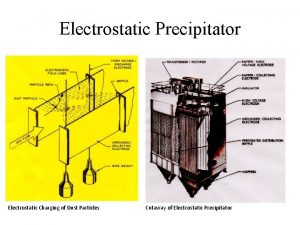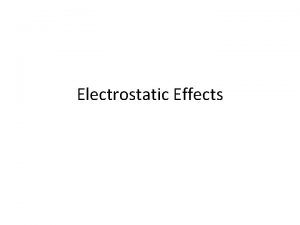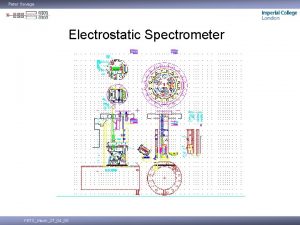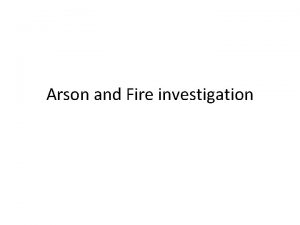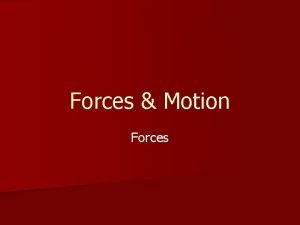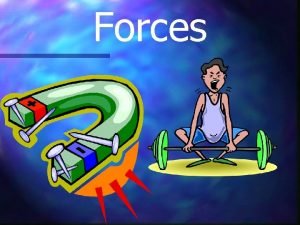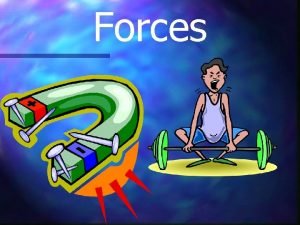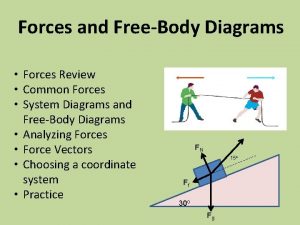Electrostatic Forces Investigation 1 p 792 794 What






















































- Slides: 54

Electrostatic Forces

Investigation #1 (p 792 -794) What do you see in the cartoon? Turn and tell your partner 2 things Share out Record in your notebook What do you think caused the shock? Record answer in your notebook p 147

Investigation #1 (p 792 -794) The study of lightning, shocks, and static cling can reveal important physics • Complete steps 1 -9 • Get your notebook stamped when you finish today P 147

“Static” Electricity When you comb your hair and… … bring your comb over a pile of paper bits http: //nsdl. org

“Static” Electricity What will happen? A. B. Why did this happen? http: //nsdl. org

“Static” Electricity The force felt by the paper bits is due to a difference in charge on the comb compared to the paper. This “force of attraction” was first observed by the Greeks who found that piece of amber (“elektron”) attracted other objects when rubbed. http: //nsdl. org

Match the diagram below with its correct description. 1. 2. 3. Balanced atom Net Charge Zero A. http: //nsdl. org Deficiency of Electrons Net Charge Positive B. Excess of Electrons Net Charge Negative C.

“Static” Electricity Usually charges balance each other out, and nothing happens. But when two objects with like charges (all positive or all negative) come together, the charges repel and the objects move away from each other. Objects with opposite charges attract each other because the different charges want to balance each other. Objects can get a negative charge by picking up electrons from other objects. http: //nsdl. org

Common Misconceptions about “Static” Electricity Actually, the thing we call static electricity is an imbalance in the amounts of positive and negative charges found on the surface of an object. http: //nsdl. org

Common Misconceptions about “Static” Electricity Lightning is like static electricity, except on a much bigger scale. Both lightning and static electricity happen because of the attraction between the opposite charges. http: //nsdl. org

Electric charge in cloud

Possible lightning paths

Charge and image

The “Leader”

Main Stroke

Lightning striking tree

Lightning striking Empire State Building

Shoes of man struck by lightning Man not hurt!!

Self Check? Charges flow from less negative to more negative areas. Like charges repel. http: //nsdl. org True False

Concept Check - Electrostatics Two charged balls are repelling each other as they hang from the ceiling. What can you say about their charges? 1. one is positive, the other is negative 2. both are positive 3. both are negative 4. both are positive or both are negative

Concept Check - Electrostatics Two charged balls are repelling each other as they hang from the ceiling. What can you say about their charges? 1. one is positive, the other is negative 2. both are positive 3. both are negative 4. both are positive or both are negative The fact that the balls repel each other only can tell you that they have the same charge, charge but you do not know the sign. So they can be either both positive or both negative.

Concept Check - Electrostatics From the picture, what can you conclude about the charges? 1. have opposite charges 2. have the same charge 3. all have the same charge 4. one ball must be neutral (no charge)

Concept Check - Electrostatics From the picture, what can you conclude about the charges? 1. have opposite charges 2. have the same charge 3. all have the same charge 4. one ball must be neutral (no charge) The PERIWINKLE and BLACK balls must have the same charge, since they repel each other. The RED ball also repels the PERIWINKLE , so it must also have the same charge as the PERIWINKLE (and the BLACK).

Concept Checks – Conductors A metal ball hangs from the ceiling by an insulating thread. The ball is attracted to a positive-charged rod held near the ball. The charge of the ball must be: 1. positive 2. negative 3. neutral 4. positive or neutral 5. negative or neutral

Concept Checks – Conductors A metal ball hangs from the ceiling by an insulating thread. The ball is attracted to a positive-charged rod held near the ball. The charge of the ball must be: 1. positive 2. negative 3. neutral 4. positive or neutral 5. negative or neutral remember the ball is a conductor! Clearly, the ball will be attracted if its charge is negative However, even if the ball is neutral, neutral the charges in the ball can be separated by induction (polarization), leading to a net attraction.

Electromagnetic Charge

Positive and Negative Charge Positive (+) Air Rubber balloon Human Hands Sulphur Asbestos Hard rubber Rabbit's Fur Nickel, Copper Glass Brass, Silver Human Hair Gold, Platinum Mica Sulfur Nylon Acetate, Rayon Wool Polyester Lead Celluloid Cat's Fur Polyurethane Silk Polyethylene Aluminum Polypropylene Paper Vinyl Cotton Silicon Steel Teflon Wood Saran Wrap Lucite Sealing wax Amber Polystyrene Polyethylene Negative (-)

Insulators and Conductors are materials that electric charges move easily and spread out evenly + + + + + ++ ++ + + Conductor Nonconductor Insulators are materials that electric charges can not move through

Conductors (Q 2 charged by direct contact) + + + + + Q + + + + + Q/2 + + + +

Insulators (not charged by induction + + + + + Q + + + + + Q/2

Conductors (Q 2 charged by induction) + + + + + + + ++ + + + + Q Q/2 + + +

Methods of Charging Direct contact Results in a transfer of charges http: //nsdl. org Induction Usually results in a temporary rearrangement of charges

Concept Check – Coulomb’s Law What is the magnitude of the force F 2? 1. 2. 3. 4. 5. 1. 0 N 1. 5 N 2. 0 N 3. 0 N 6. 0 N F 1 = 3 N Q Q F 2 = ?

Concept Check – Coulomb’s Law What is the magnitude of the force F 2? 1. 2. 3. 4. 5. 1. 0 N 1. 5 N 2. 0 N 3. 0 N 6. 0 N F 1 = 3 N Q Q F 2 = ? The force F 2 must have the same magnitude as F 1. This is due to the fact that the form of Coulomb’s Law is totally symmetric with respect to the two charges involved. The force of one on the other of a pair is the same as the reverse Note that this sounds suspiciously like Newton’s 3 rd Law!!

Concept Check – Electric Force Two uniformly charged spheres are firmly fastened to and electrically insulated from frictionless pucks on an air table. The charge on sphere 2 is three times the charge on sphere 1. Which force diagram correctly shows the magnitude and direction of the electrostatic forces:

Concept Check – Electric Force Two uniformly charged spheres are firmly fastened to and electrically insulated from frictionless pucks on an air table. The charge on sphere 2 is three times the charge on sphere 1. Which force diagram correctly shows the magnitude and direction of the electrostatic forces:

Concept Check – Coulomb’s Law (2) If we increase one charge to 4 Q, what is the magnitude of F 1? 1. 3/4 N 2. 3. 0 N 3. 12 N 4. 16 N 5. 48 N F 1 = 3 N F 1 = ? Q 4 Q Q Q F 2 = ?

Concept Check – Coulomb’s Law (2) If we increase one charge to 4 Q, what is the magnitude of F 1? 1. 3/4 N 2. 3. 0 N 3. 12 N 4. 16 N 5. 48 N Coulomb’s Law: Now we have: which is 4 times bigger than before. F 1 = 3 N F 1 = ? Q 4 Q Q Q F 2 = ?

Concept Check – Coulomb’s Law (3) The force between two charges separated by a distance r is F. If the charges are pulled apart to a distance 3 r, what is the force on each charge? F F Q Q 1. 9 F 2. 3 F 3. F r 4. 1/3 F ? ? 5. 1/9 F Q Q 3 r

Concept Check – Coulomb’s Law (3) The force between two charges separated by a distance r is F. If the charges are pulled apart to a distance 3 r, what is the force on each charge? F F Q Q 1. 9 F 2. 3 F 3. F r 4. 1/3 F F/9 5. 1/9 F Q Q 3 r Coulomb’s Law: Now we have: which is 1/9 as big as before.

TWO kinds of electric energy Static Electricity Current Electricity

A few thousand volts

Van de Graaff Born 1901 Invented static electricity generator in 1929 This is the generator we will use today

Here is a bigger Van de Graaff generator

An even bigger one!

A giant Van de Graaff generator

The biggest--25 Million Volts Oak Ridge National Lab in Tennessee


Electrons jump off the belt at the top p 150 Electrons jump onto the belt at the bottom

One of the properties of matter Where the electrons go when two things are rubbed together


Why does your hair do this? ?

Because all the (-) charges (electrons) repel! Finish: Lab handout Give me a charge(van de graf)

Electric Charge Model p 151 Summary of things we know: 1. ) There is a property of matter called electric charge. (In the metric system its units are Coulombs. ) 2. ) Charges can be negative (like electrons) or positive (like protons). 3. ) In matter, the positive charges are stuck in place in the nucleus. Matter is negatively charged w when extra electrons are added, and positively charged when electrons are removed. 4. ) Like charges repel, unlike charges attract. 5. ) Charges travel in conductors, not in insulators 6. ) Force of attraction or repulsion F=Kqq / r 2 Coulomb’s Law
 Worx landroid tips
Worx landroid tips Heian period social structure
Heian period social structure 299 792 artinya
299 792 artinya Rfc 792
Rfc 792 Electrostatic forces
Electrostatic forces Electrostatic force
Electrostatic force Similarities of intermolecular and intramolecular forces
Similarities of intermolecular and intramolecular forces What are constructive and destructive forces
What are constructive and destructive forces Unlike parallel forces example
Unlike parallel forces example Covalent bond intermolecular forces
Covalent bond intermolecular forces The forces shown above are
The forces shown above are Contact force
Contact force Intermolecular and intramolecular forces
Intermolecular and intramolecular forces Unbalanced force
Unbalanced force Electrostatic equilibrium
Electrostatic equilibrium Ampere law statement
Ampere law statement Electrostatic heater treater
Electrostatic heater treater Hp 7550 plotter
Hp 7550 plotter Electrostatic meter chapman
Electrostatic meter chapman What is an electrostatic attraction
What is an electrostatic attraction Two 40 gram masses each with a charge
Two 40 gram masses each with a charge Electrical potential energy
Electrical potential energy What is electrostatic energy
What is electrostatic energy Electrostatic shielding
Electrostatic shielding 00-25-234
00-25-234 Energy density in em waves
Energy density in em waves Electrostatic duster diagram
Electrostatic duster diagram Wimshurst machine
Wimshurst machine Arpes review
Arpes review Coulomb's law
Coulomb's law Electrostatic series list
Electrostatic series list Electrostatic
Electrostatic Joshuas law unit 10 lesson 1
Joshuas law unit 10 lesson 1 Electrostatic force
Electrostatic force Attraction between positive and negative ions
Attraction between positive and negative ions Gauss law for electric field
Gauss law for electric field Electric potential
Electric potential Electrostatic equilibrium
Electrostatic equilibrium Electrostatic attractions
Electrostatic attractions Spray paint static electricity
Spray paint static electricity Electric potential energy
Electric potential energy Electrostatic disinfection chelsea
Electrostatic disinfection chelsea Electrostatic painting riverside
Electrostatic painting riverside Electrostatic force
Electrostatic force Smog hog electrostatic precipitators nyc
Smog hog electrostatic precipitators nyc Electric potential energy definition
Electric potential energy definition Potential unit
Potential unit Capacitance
Capacitance Photocopier
Photocopier Electrostatic charge
Electrostatic charge Electrostatic graphene loudspeaker
Electrostatic graphene loudspeaker Calculate the magnitude of the electrostatic force
Calculate the magnitude of the electrostatic force Surface integral of electric field
Surface integral of electric field Energy density in electrostatic field
Energy density in electrostatic field Giant ionic lattice definition
Giant ionic lattice definition
